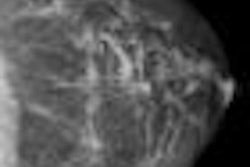The use of a digital breast tomosynthesis (DBT) system can reduce recall rates by up to 30% in screening and diagnostic mammography, according to a study published in the August issue of the American Journal of Roentgenology.
DBT systems use motorized gantries that enable the acquisition of data in tomographic slices in an arc around the breast. The slices can be reconstructed into 3D volumes, which can reduce the difficulty in interpretation caused by the overlapping of tissue on conventional projection mammograms.
Possible benefits of the technology include improving cancer detection in women with dense breast tissue; making the diagnosis of benign findings more effective and, thus, reducing the number of biopsies; and perhaps most importantly from the patient's perspective, reducing recall rates in screening mammography.
Researchers at the University of Pittsburgh and Magee-Womens Hospital, also in Pittsburgh, conducted an observer performance study comparing the diagnostic performance of conventional full-field digital mammography (FFDM) and DBT with respect to recall rates. Their findings were published in this month's American Journal of Roentgenology (August 2009, Vol. 193:2, pp. 586-591).
David Gur, Sc.D., and colleagues selected 125 examinations, 35 with verified cancer and 90 with no cancer findings. Eight radiologists interpreted the images under four display conditions:
- Conventional digital mammography alone (mode 1)
- 11 low-dose projection DBT images (mode 2)
- Reconstructed DBT images (mode 3)
- Combined display of digital mammography and DBT (mode 4)
Observer performance levels were measured as the proportion of exams that prompted recall for further evaluation, Gur and colleagues wrote.
Gur's team asked the eight readers to review and rate the images from each exam for the presence or absence of abnormalities under the four reading conditions, and to assume that the reading was the initial screening exam.
The exams that took the longest to read were viewed in combined digital mammography and DBT mode (mode 4); the shortest reading times were with conventional full-field digital mammography alone (mode 1).
Readers performed at a higher sensitivity and specificity when viewing and rating the exams using DBT alone (mode 3) and with a combination of conventional digital mammography and DBT (mode 4). The readers' overall performance using digital mammography alone had lower specificity (0.60 versus 0.72) and sensitivity (0.88 versus 0.93) than when the readers used mode 4, combining digital and DBT.
But the most dramatic difference was in recall rates, Gur and colleagues wrote, with the use of combined DBT and digital mammography showing a 30% reduction in recall rate for cancer-free exams that would have led to a recall if digital had been used alone.
"Our findings regarding the reduction in recall rates associated with the use of digital breast tomosynthesis and FFDM combined are likely to remain valid in experimental studies that more closely simulate the actual clinical environment and in the actual clinical environment as well," the authors wrote.
But DBT will require some training, they cautioned.
"Our experience to date indicates that unlike simple image-processing routines, the appropriate, accurate, and efficient use of digital breast tomosynthesis will necessitate substantial training in recognition not only of the appearance of various abnormalities but also of the appearance of the widely varying normal tissue causing negative findings," they wrote.
By Kate Madden Yee
AuntMinnie.com staff writer
August 4, 2009
Related Reading
ECR delivers new findings on digital breast tomosynthesis, March 7, 2009
New breast imaging applications show diagnostic promise, January 20, 2009
Pilot study: DBT's role needs further research, April 18, 2008
ECR sessions examine DBT's effectiveness, March 7, 2008
Copyright © 2009 AuntMinnie.com



















